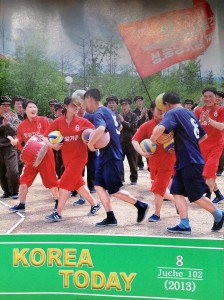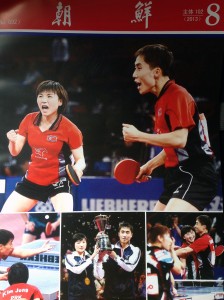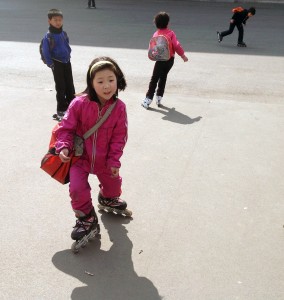Sports!
This month, the front covers of two of my favorite magazines, Korea and Korea Today, both feature athletics. One shows a sort of mass participatory event, perhaps a youth camp. The other shows the elite table tennis players who defeated their southern kin in the finals of the world championships a couple months ago. These magazines generally exist to inform foreigners that everything is great in North Korea and only getting better. While one can be skeptical of some of their claims, the focus on sports is neither incidental nor insignificant but could have some important implications for the Kim Jong Un era.


Sports, at the mass participatory level, at a domestic professional level and at the international level as a form of détente are being promoted like never before. We can expect sports to be used to highlight improved quality of life for the people, beautified cityscapes and as an outlet for patriotism during militarily calmer periods. Diplomatic signals are also being sent through sports. While it may seem absurd that a major actor in the international outreach component is 1990s NBA bad boy, Dennis Rodman, the player’s return visit to Pyongyang this month suggests that Kim Jong Un plans to keep this avenue open.
Kim Jong Il was famously, but more passively, an NBA basketball fan. He was rumored to have extended an invitation to Michael Jordan to visit Pyongyang but had to settle for a signed basketball as a gift from Secretary of State Madeline Albright in 2000. (The ball now sits in the massive, underground International Friendship Exhibition in Mount Myohyang, along with other gifts ranging from bulletproof cars to ashtrays.) Up until that point in Kim Jong Il’s rule, sports had plummeted to an understandable nadir in the 1990s, though the 2000s saw a resurgence of DPRK athletes participating in international events. But while following top athletes, particularly association football, has always been popular for North Koreans, participation in sports has been quite low. Certainly, the use of high-tech and indoor facilities has been generally limited to all but the most talented athletes.
In the DPRK, as most places, sports serve as an outlet for patriotism at the national level, tribalism or regionalism at a domestic professional level, as a form of discipline for youths and recreation for adults. It has always had a place in North Korean life, but this year’s relentless promotion of sports is uniquely intense and comprehensive.
Last November, the DPRK’s Political Bureau established the State Physical Sports and Culture Commission, a 32-member organization that aims to oversee sports and athletics in the DPRK. Jang Song Thaek was installed as the head of this commission, which led some pundits to speculate that it was going to be an institution from which he could wield power.[1] However, as the year anniversary approaches, it seems that probably the inverse is true: rather than the institution giving power to Jang, Jang has given the institution power. This is a case of something in North Korea being very much what it seems: an allocation of political, social and economic capital to the field of athletics.
The name of the game in the DPRK is control of assets. This is true for ministries, the military and party organizations. Complex and opaque patronage networks define who gets what in this game and creating a sports commission with one of the two most powerful men in the country at its helm ensures that potent political and business connections can be used to channel resources towards sports facilities and programs.
Attention is certainly being drawn towards sports, as it is garners more time on TV and more space in print this year. Some of this is the fairly unsurprising nationalist propaganda, such as the North Korean women’s under-20 football team winning the East Asian Cup. For Pyongyang, this victory was as good as it gets: the team beat South Korea in the semis and then China in the final, which took place in Seoul on the anniversary of the Korean War armistice.
Also, there seem to be longer and more frequent broadcasts of foreign sports news on KCTV. Showing European soccer highlights, without any Korean connection at all, only serves to drive interest in the sport by showing what it looks like as is practiced elsewhere at the highest levels. There is an aspirational component to this coverage.
Unusually for a country without a significant middle class, sports are also being heavily promoted in the media as a desirable recreation for the masses. Part of Kim Jong Un’s beautification program has seen new parks and facilities springing up largely in Pyongyang, but also in other cities. New basketball and volleyball courts abound and kids strapped into rollerblades skating in special rinks can be widely seen.
As a rollerblading instructor put it in a Korea Today article (one feels that Korea Today ought to have an exclamation mark in the title, but that is another issue): “Even if you have somewhat good technique you can hardly roller-skate on the semicircular slope. And if you have a better technique cannot perform tricks unless you have guts. We teach the knack to the enthusiasts who are short of guts though with a technique.” Okay, so that may not make perfect sense, but he goes on to explain that they are always scouting for kids with athletic aptitude and tries to persuade their parents “to make athletes of them.” Don’t be surprised if South Korea’s dominance of speed skating is challenged in the coming decade by its northern neighbors. Other facilities in Pyongyang’s “sports district,” built for the 1989 World Festival of Youth and Students, are also being refurbished to nurture young athletes.

In fact, targeting the medal podium at the 2018 Olympics in Pyongchang is not out of the question. One of the summer’s key propaganda slogans is “Masikgyong speed!” referring to a ski resort on the east coast being built supposedly at an incredible pace. In order to reemphasize the importance of the facility on the heels of the Swiss government blocking the sale of a cable car, Kim Jong Un called on the resort in August, his second visit this year. As much as tourism is a desired outcome for this park (and not coincidentally, North Korea’s interest in Special Economic Zones focused on tourism is very high right now) it would also be a domestic training venue for top athletes. North Korea has only won two medals at the winter games, the last one coming in 1992. North Korean officials have even cautiously floated the most optimistic vision of Masikryong possible, suggesting that if things go well, South Korea might even share some of the 2018 Winter Olympics with the North.[2]
Winning prestigious sporting events is a major impetus for the “let’s-all-love-sports” campaign. Sporting triumphs may also provide an outlet for nationalist rallying during geopolitically calmer times. One can imagine a situation in the coming years where Pyongyang’s strategic goals will require some sort of détente or at least negotiations with the US and South Korea. Should such a détente occur, North Korea would need to avoid testing any ballistic or nuclear technologies for a period of time in order not to scupper any cooperation that might develop. It would be extremely useful then to have other victories to inspire patriotic pride. Sports, as in any country, can provide this.
Certainly, pointing to sporting victories will be easier than pointing to economic ones if Pyongyang maintains its ambivalence to reform. While the new leadership has demonstrated some interest in economic policy experimentation, the reticence to change that was the hallmark of the Kim Jong Il era is still evident. Both national sporting victories and the urban beautification projects that center around leisure activities—the rollerblading rinks, basketball courts and swimming pools—can be read as a means of buying time, while economic and foreign policy options are explored.
Overall, the sports campaign is also congruous with Kim Jong Un’s brand. As we’ve seen in the past year, the younger Kim has had a distinct niche carved out on his behalf. He clearly projects an approachable, friendly leadership style; one newish song is called “Friendly Comrade Kim Jong Un,” lest there be any doubt. Perhaps most importantly, however, rather than avoid the issue of his age, his public relations team has embraced it, emphasizing his youth, vitality and energy. Promoting sports at a mass-participatory and competitive level has a high degree of cogence with this branding process.
The Dennis Rodman visit in March 2013 also fit in with this brand: to the domestic audience, this played very much as a gesture of regret and friendship by US citizens whose government was putting pressure on their young leader following the December rocket launch and February nuclear test. It demonstrated the high value Kim places on athletics (even imperialists can come if its for sports!) and allowed him to appear relaxed and gregarious with a delegation of American visitors.
Reviews of Rodman’s return visit read reminiscent of the Star Wars prequels: lacking focus, barely coherent and an exercise in visual style over considered substance. As such, the US State Department may not yet take this as serious avenue for rapprochement, but the repeat visit plus Kim’s invitation for Rodman to continue exploring ideas for athletic exchanges suggests a degree of commitment to this odd channel from the North Korean side. (We should also note that the most absurd element to foreign observers—the sponsorship of the trip by a gambling company—will not register at all to the domestic audience, which once again, only sees its leader as reaching out to Americans.)
A few days after the return of Rodman to Pyongyang, a South Korean weightlifting team arrived to participate in the 2013 Asia Cup and Asia Club Weightlifting tournament, which gathered participants from across the continent. A second rate weightlifting tournament may not be significant, except that not only did a South Korean team take part, but Pyongyang agreed that when they won medals, the Republic of Korea national flag, the “Taegukgi,” would be hoisted. This is a remarkable first, something that even halcyon days of sunshine never brought about. The message to the rest of the world is that the DPRK wants to be taken seriously as a normal and apolitical athletic nation. One wonders how domestic audiences took this gesture; an intriguing curiosity, no doubt, seeing the enemy flag raised in a gym built by the founder of Hyundai.
Away from the elite level, one also wonders about some of the unintended optics of the mass participatory element of the sportsmania. One consequence may be that the divide between the haves and have-nots will acquire another visible symbol. This also fits in with recent trends in North Korean society, where a small but growing class of people not only has greater access to consumer goods but also is unafraid to display that consumption openly. Sport as recreation generally has very middle class roots and often requires costly equipment, such as rollerblades. It also requires sufficient food and energy and free time. The Swiss government’s perspective on the Masikryong ski resort is that it would be a luxury for elites. (While that is true, it will likely also be used as a showpiece for work unit vacations in the wintertime, when Arirang isn’t running and other political venues are simply too cold to enjoyably visit.)
Ultimately, the North Koreans plan to show off the ski resort, other facilities and accomplishments to both a domestic and international audience. While those of us who pay attention to the DPRK often have to search for subtexts and ulterior motives, the new sports-crazy North Korea is doing just what it says on the tin: trying to become a sporting powerhouse by supporting athletes both at a grassroots and competitive level.
[1] See, for example, “N. Korea’s Party Poliburo Sets Up Powerful Sports Commission,” North Korea Newsletter No. 235, Yonhap News, November 8, 2012, http://english.yonhapnews.co.kr/northkorea/2012/11/07/9/0401000000AEN20121107009300325F.HTML.
[2] Kang Tae-ho, “North Korea expresses interest in 2018 Pyeongchang Olympics,” The Hankyoreh, September 4, 2013, http://www.hani.co.kr/arti/english_edition/e_northkorea/602104.html.
